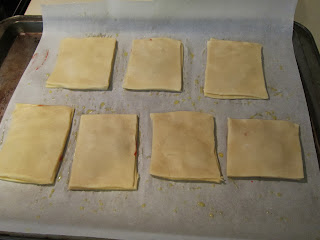Toaster Pastries
Makes 6 pasteries
One recipe pie crust
Flour for work area
1 large egg, beaten with 1 Tbsp. water
6 Tbsp filling of choice
Optional: powdered sugar for dusting
1. Prepare the pie crust described in my last post....it's here.
2. Preheat the oven to 375 degrees. Line baking sheet with parchment paper.
3. Roll the first disc of pie crust on a lightly floured surface into a 9 x 12 inch rectangle, cutting any errant edges with a sharp knife.
4. Cut the rectangle into six smaller rectangles. Gently separate the rectangles from the work surface and lay them on the prepared baking sheet with at least 2 inches between them.
Since I was using left over pie crust, my rectangles were all different shapes and sizes, which suit my family.
I made 7!
5. With a pastry brush, paint each rectangle with the egg wash. You will have some egg mixture left, set that aside.
6. Scoop 1 tablespoon of filling onto each rectangle with filling in a thin line down the center.I used my yummy strawberry freezer jam for filling. But feel free to use whatever you want....for example, any jam flavor, Nutella, or cinnamon and sugar. You can even make them savory with pesto, ricotta, tomato sauce and cheese....you get the idea.
7. Roll out the other disk of pie crust and repeat steps 3 and 4. Lay the new batch of rectangles over the filling and seal them together by pressing a fork around the perimeter.
8. Bake for 20-25 minutes, or until golden. Cool on a wire rack for at least 20 mniutes before dusting with powdered sugar or glazing with powdered sugar frosting.
They were very good and worth the extra effort....especially for something special. We all loved them and my oldest daughter already requested them for a special treat for her birthday breakfast. They are not something we would have all the time, but that's what makes them a treat:)











